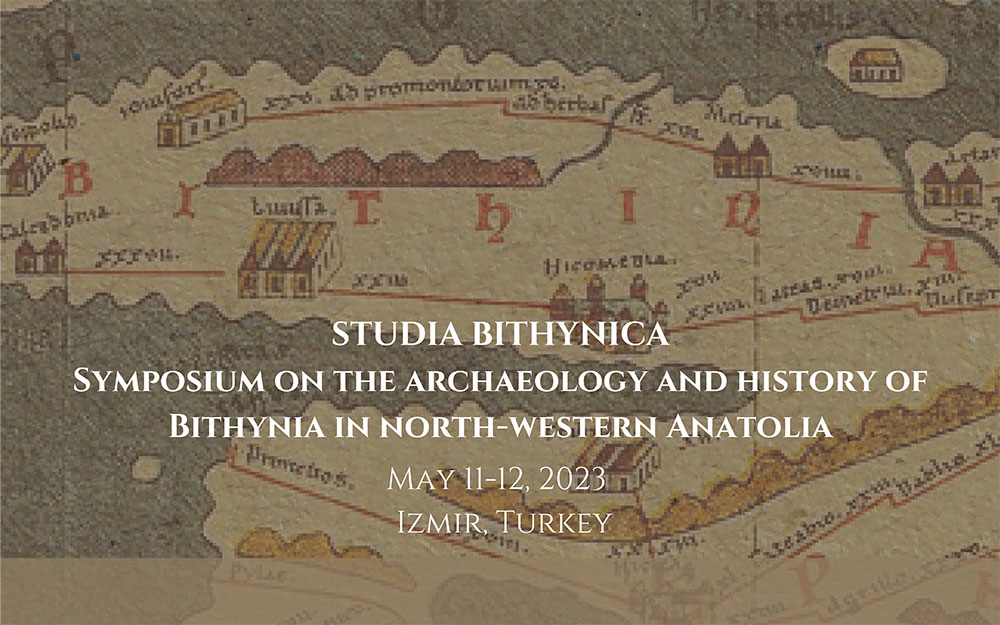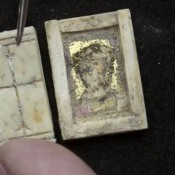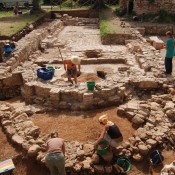“Studia bithynica. An e-conference on the archaeology and history of Bithynia in north-western Anatolia” is an international conference scheduled to take place on May 11-12, 2022 via Zoom.us.
Bithynia was an ancient region and Roman province located on the southeastern edge of the Marmara Sea in the northwestern part of present-day Turkey. It was bordered by Mysia, Paphlagonia, and Phrygia. From the fourth
century B.C. it was an independent Hellenistic kingdom, and around 74 B.C. it became a Roman province. During the seventh century A.D., it was incorporated into the Byzantine theme of Opsikion. It became a border region to the Seljuk Empire in the 13th century and was eventually conquered by the Ottoman Empire in the early 14th century. Several major cities of Bithynia sat on the fertile shores of the Propontis or in the forested inland, such as Nicomedia (İzmit-Kocaeli), Nicaea (İznik), Chalcedon (Kadıköy), Cius (Gemlik), Prusa ad Olympum (Bursa) and Apamea Myrlea (Mudanya). Besides being a coastal region, it is also occupied by mountains as well as forests and has valleys of great fertility. Since the studies of F.K. Dörner in the 1950s, archaeologically and historically Bithynia became a special focus in the fields of ancient Anatolian studies.
Studia bithynica: about
The aim of this online video conference is to report on the state of research concerning Bithynia during the Greek, Roman, and Byzantine periods between ca. early sixth century B.C. and early 14th century A.D. We warmly welcome submissions from senior and junior scholars, including advanced graduate students and postdoctoral scholars from a variety of disciplines related to this Anatolian region. We intended to bring together researchers who can present new syntheses of archaeological data from Bithynia and enter into dialogue with scholars working on the same material subsets. Intended to bring together scholars of Greek, Roman, and Byzantine archaeology to discuss a range of issues concerning Bithynia, this electronic conference is an excellent opportunity to increase our knowledge about this region. Such papers that engage the following themes and topics are invited:
– Bithynia during the Archaic, Classical, Hellenistic, Roman, and Byzantine periods,
– Archaeological field projects in Bithynia,
– Museum studies in Kocaeli, İznik, Bursa, Istanbul, Bolu, and Düzce as well as abroad,
– Ancient Greek, Latin, and Byzantine authors and other textual as well as cartographic sources on Bithynia and
Bithynians,
– Bithynia during the Late Iron Age,
– Bithynia and the Achaemenid Persian Empire during the sixth and fifth centuries B.C.,
– The Hellenistic kingdom of Bithynia and its rulers,
– Pre-Roman tumuli in Bithynia and their archaeology,
– The coinage of the Kingdom of Bithynia and the Roman province of Bithynia,
– The Roman province of Bithynia et Pontus (after the two legendary volumes of Chr. Marek in 1993 and 2003),
– Roman provincial administration in Bithynia,
– Historical geography and settlement patterns in pre-Hellenistic, Hellenistic, Roman and Byzantine Bithynia,
– Bithynia and Propontis,
– Two Bithynian cities and their interregional relationships: Nicomedia and Nicaea (after the 2020 volume of Asia
Minor Studien no. 96 on the recent studies about Nicomedia and Nicaea),
– Epigraphic and numismatic studies in Bithynia during the Hellenistic, Roman, and Byzantine periods,
– Geographical, cultural, and ethnic borders of Bithynia,
– Relationships between Bithynia and neighboring regions,
– Roads, routes, and population in Bithynia,
– Military archaeology in Roman Bithynia,
– The province Bithynia under the tetrarchy reform of Emperor Diocletian in A.D. 296,
-Roman Bithynia and Christianity to the mid-fourth century A.D. (after the Michigan dissertation of G.J.
Johnson in 1984),
– Religious conflict in Late Roman Nicomedia and the rest of Bithynia,
-The Christian martyrs of the late third-early fourth century A.D. in Bithynia,
– Forms of Christian presence in Late Roman and Early Byzantine Bithynia,
– Episcopal sees of the Late Roman Bithynia,
– Jews and Jewish heritage in Roman and Early Byzantine Bithynia,
– Bithynia’s companion for the Christianity and early eastern Orthodox Church,
– Notable personalities of Hellenistic, Roman, and Byzantine Bithynia (e.g., Arrian, Cassius Dio, and Helena),
– The Byzantine province of Opsikion (after the TIB’s volume no. 13 in 2020 on Bithynia and Hellespontus by
K. Belke)
– Middle and Late Byzantine studies in Bithynia,
– Miscellanea.
On these themes and questions, all approaches and methods susceptible to bringing some progress to our current knowledge are of course welcome: archaeology, ancient history, historical geography, epigraphy, numismatic, history of art, cultural anthropology, etc. The symposium will take place virtually on Zoom. All the readings and discussions will be in English and recorded for later viewing on YouTube. The proceedings of the symposium will be published in 2025. The symposium is free of charge.
Participation – application deadline
If interested to participate, please contact the organizers Ergün Lafli ([email protected]) or Zoe Tsiami [email protected] before January 1, 2023, with a message including
– Type of your participation (virtual lecturer or virtual observer):
– Name
– Academic title
– Institution
– E-mail
– Complete professional address
– Cell phone
– Academia or Researchgate account
– Orcid ID
– Could your virtual lecture be recorded and later displayed on YouTube?
– Any special requests
– Title of your lecture
– Your abstract
– NB: One or two illustrations can be included which should be sent by e-mail to [email protected] and/or
[email protected]



